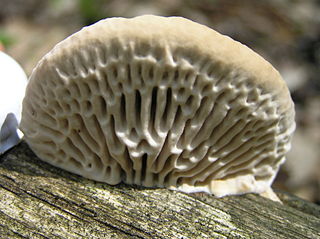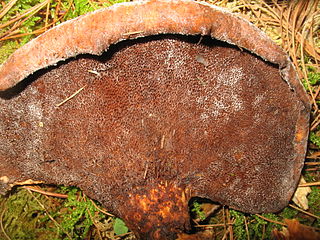
Taphrina is a fungal genus within the Ascomycota that causes leaf and catkin curl diseases and witch's brooms of certain flowering plants. One of the more commonly observed species causes peach leaf curl. Taphrina typically grow as yeasts during one phase of their life cycles, then infect plant tissues in which typical hyphae are formed, and ultimately they form a naked layer of asci on the deformed, often brightly pigmented surfaces of their hosts. No discrete fruit body is formed outside of the gall-like or blister-like tissues of the hosts. The asci form a layer lacking paraphyses, and they lack croziers. The ascospores frequently bud into multiple yeast cells within the asci. Phylogenetically, Taphrina is a member of a basal group within the Ascomycota, and type genus for the subphylum Taphrinomycotina, the class Taphrinomycetes, and order Taphrinales.

The Discinaceae are a family of ascomycete fungi, the best known members of which are the false morels of the genus Gyromitra. Originally erected by Erich Heinz Benedix in 1961, it was found to be a discrete clade in a molecular study of ribosomal DNA by mycologist Kerry O'Donnell in 1997. As of 2008, the family is thought to contain 5 genera and 58 species.

Daedalea is a genus of fungi in the family Fomitopsidaceae. The genus was circumscribed in 1801 by mycologist Christian Hendrik Persoon, based on the type D. quercina and four other species. The generic name is derived from the Ancient Greek δαιδαλεος.

Fomitopsis is a genus of more than 40 species of bracket fungi in the family Fomitopsidaceae.

Banksiamyces is a genus of fungi in the order Helotiales, with a tentative placement in the family Helotiaceae. The genus contains four species, which grow on the seed follicles of the dead infructescences or "cones" of various species of Banksia, a genus in the plant family Proteaceae endemic to Australia. Fruit bodies of the fungus appear as small, shallow dark cups on the follicles of the Banksia fruit. The edges of dry fruit bodies fold inwards, appearing like narrow slits. The first specimens of Banksiamyces, known then as Tympanis toomansis, were described in 1887. Specimens continued to be collected occasionally for almost 100 years before becoming examined more critically in the early 1980s, leading to the creation of a new genus to contain what was determined to be three distinct species, B. katerinae, B. macrocarpus, and B. toomansis. A fourth species, B. maccannii, was added in 1984.

Ceriporia is a widely distributed genus of crust fungi.

Gymnopilus dilepis is a species of mushroom in the family Cortinariaceae. This species is found in India and North America. It was given its current name by mycologist Rolf Singer in 1951.

Irpex is a genus of corticioid fungi in the order Polyporales. Species produce fruit bodies that grow as a crust on the surface of dead hardwoods. The crust features an irpicioid spore-bearing surface, meaning it has irregular and flattened teeth. Irpex is distinguished from the similar genera Junghuhnia and Steccherinum by the simple septa found in the generative hyphae.

Coriolopsis is a genus of fungi in the family Polyporaceae. It was circumscribed by American mycologist William Alphonso Murrill in 1905. The genus is cosmopolitan, with most species in tropical areas. The generic name combines the name Coriolus with the Ancient Greek word ὄψις ("appearance").

Echinochaete is a genus of fungi in the family Polyporaceae. Circumscribed by English mycologist Derek Reid in 1963, the genus is widespread in tropical regions and contains five species.
Grammothele is a genus of poroid crust fungi in the family Polyporaceae.
Episphaeria is a genus of fungus in the Agaricales. The genus is monotypic, and contains the single rare species Episphaeria fraxinicola, found in Europe. Its familial position is not known with certainty. The tiny fruit bodies of the fungus resemble minute, white cups that grow scattered or in groups on the bark of ash trees.

Banksiamyces toomansis is a species of fungus in the family Helotiaceae. It was first described as Tympanis toomansis by Miles Joseph Berkeley and Christopher Edmund Broome in 1886, and transferred to the genus Encoelia in 1957 by R.W.G. Dennis. Gordon William Beaton transferred it to Banksiamyces in 1982.

Corallomycetella is a genus of ascomycete fungi in the family Nectriaceae. Species of Corallomycetella are tropical, and are characterized by the formation of brightly colored rhizomorphs of their rhizostilbella-like asexual morphs. These fungi causes a number of plant diseases including 'violet root rot' of Theobroma cacao, root rot of Carica papaya, and 'stinking root disease' of several tropical woody plants. Two species of Corallomycetella are recognized: Corallomycetella elegans C. Herrera & P. Chaverri and Corallomycetella repens Rossman & Samuels. Corallomycetella jatrophae is now classified under Corallonectria.

Lactarius scoticus is a member of the large milk-cap genus Lactarius in the order Russulales. It is found in Europe, where it grows in peat bogs in a mycorrhizal association with birch.

Discinella terrestris is a species of fungus in the family Helotiaceae. It was first described as Helotium terrestre by Miles Joseph Berkeley and Christopher Edmund Broome in 1882, from collections made in Brisbane. R.W.G. Dennis transferred it to the genus Discinella in 1958.
Pseudolagarobasidium is a genus of nine species of crust fungi in the family Phanerochaetaceae. It was circumscribed in 1985. The type species, P. leguminicola, is associated with stem and root rot of the mimosoid tree Leucaena leucocephala. Pseudolagarobasidium species grow on wood, and may be saprobes, endophytes, or parasites.
Vizella is a genus of leaf-inhabiting fungi in the class Dothideomycetes, and the type genus of the family Vizellaceae. The genus was circumscribed by Pier Andrea Saccardo in 1883.
Stilbum is a genus of fungi in the family Chionosphaeraceae. The genus was circumscribed by German mycologist Heinrich Julius Tode in 1790, with Stilbum vulgare as the type species.














